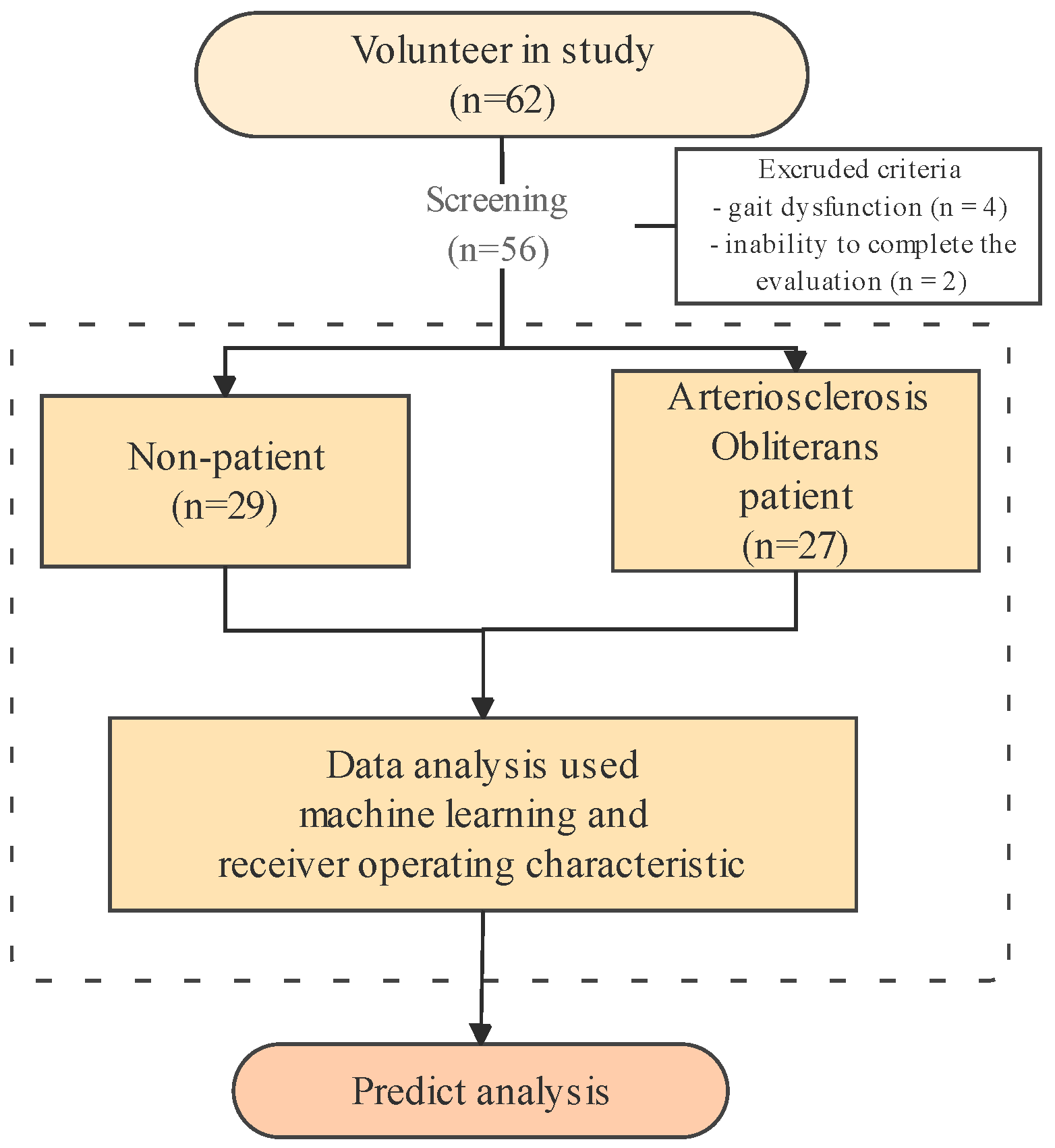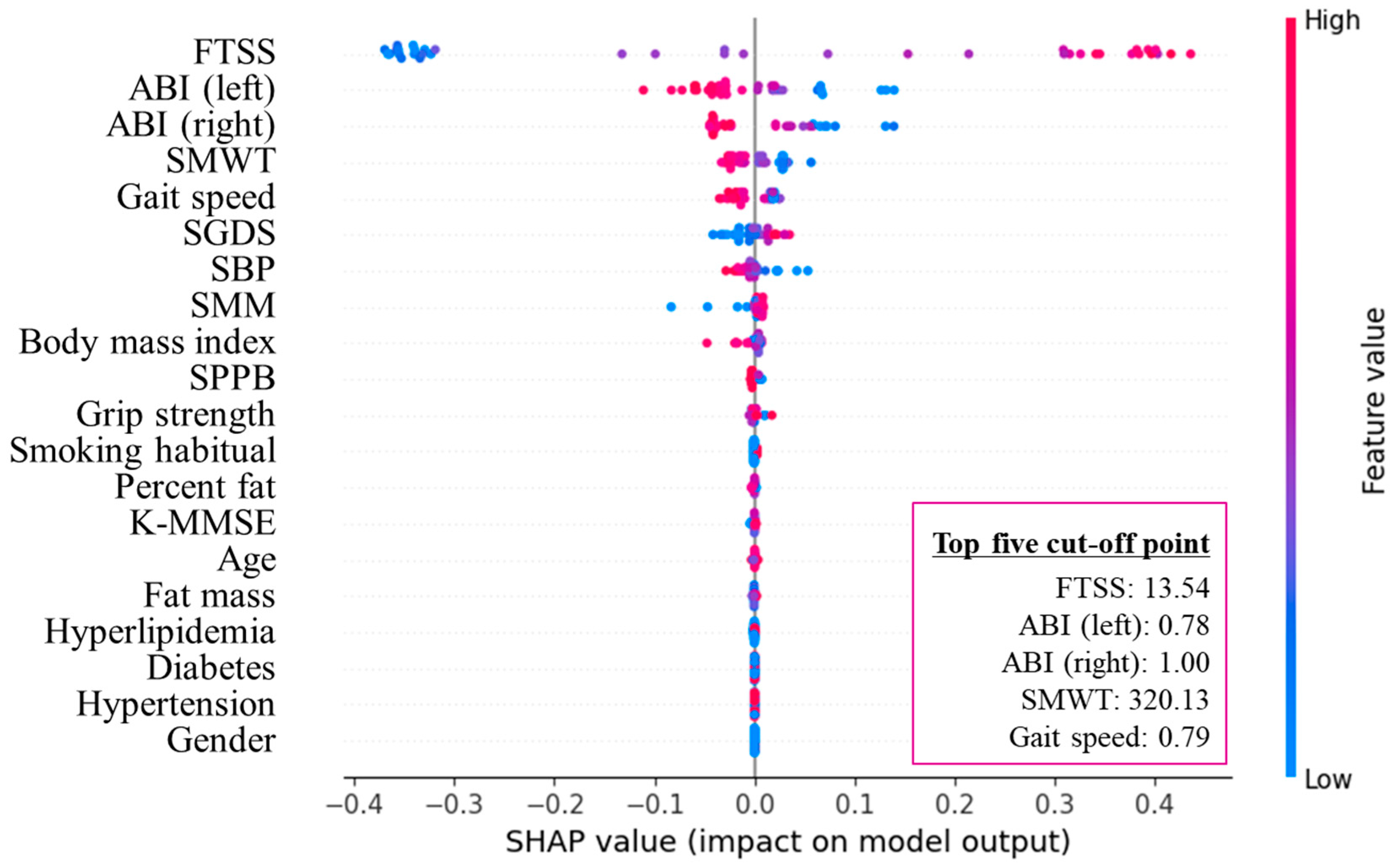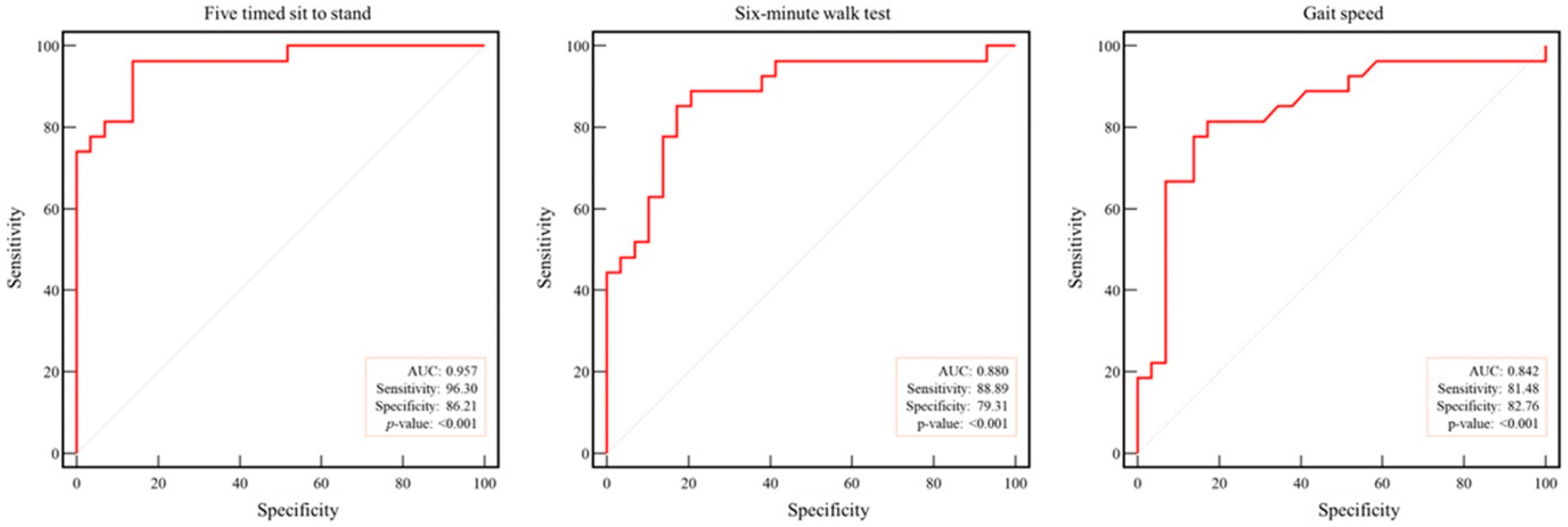Diagnostic Value of the Five Times Sit-to-Stand Test and Other Functional Measures in Patients with Arteriosclerosis Obliterans
Abstract
1. Introduction
2. Materials and Methods
2.1. Study Design and Participants
2.2. Clinical Measurements
2.3. Physical Function Measurements
2.4. Other Measurements
2.5. Statistical Analysis
3. Results
4. Discussion
5. Conclusions
Author Contributions
Funding
Institutional Review Board Statement
Informed Consent Statement
Data Availability Statement
Acknowledgments
Conflicts of Interest
Abbreviations
| ABI | Ankle-Brachial Index |
| AHA | American Heart Association |
| ASO | Arteriosclerosis Obliterans |
| AUC | Area Under the Curve |
| BMI | Body Mass Index |
| COPD | Chronic Obstructive Pulmonary Disease |
| CT | Computed Tomography |
| DBP | Diastolic Blood Pressure |
| FTSS | Five Times Sit-to-Stand Test |
| IRB | Institutional Review Board |
| K-MMSE | Korean Mini-Mental State Examination |
| PAOD | Peripheral Arterial Occlusive Disease |
| ROC | Receiver Operating Characteristic |
| SBP | Systolic Blood Pressure |
| SGDS-K | Short form of the Geriatric Depression Scale in the Korean language |
| SHAP | Shapley Additive Explanations |
| SMWT | Six-Minute Walk Test |
| SMM | Skeletal Muscle Mass |
| SPPB | Short Physical Performance Battery |
References
- Gerhard-Herman, M.D.; Gornik, H.L.; Barrett, C.; Barshes, N.R.; Corriere, M.A.; Drachman, D.E.; Fleisher, L.A.; Fowkes, F.G.R.; Hamburg, N.M.; Kinlay, S.; et al. 2016 AHA/ACC guideline on the management of patients with lower extremity peripheral artery disease: A report of the American College of Cardiology/American Heart Association Task Force on Clinical Practice guidelines. J. Am. Coll. Cardiol. 2017, 69, e71–e126. [Google Scholar] [CrossRef]
- Aboyans, V.; Ricco, J.B.; Bartelink, M.E.L.; Björck, M.; Brodmann, M.; Cohnert, T.; Collet, J.P.; Czerny, M.; De Carlo, M.; Debus, S.; et al. 2017 ESC Guidelines on the Diagnosis and Treatment of Peripheral Arterial Diseases, in collaboration with the European Society for Vascular Surgery (ESVS): Document covering atherosclerotic disease of extracranial carotid and vertebral, mesenteric, renal, upper and lower extremity arteriesEndorsed by: The European Stroke Organization (ESO)The Task Force for the Diagnosis and Treatment of Peripheral Arterial Diseases of the European Society of Cardiology (ESC) and of the European Society for Vascular Surgery (ESVS). Eur. Heart J. 2018, 39, 763–816. [Google Scholar] [CrossRef]
- Fowkes, F.G.R.; Rudan, D.; Rudan, I.; Aboyans, V.; Denenberg, J.O.; McDermott, M.M.; Norman, P.E.; Sampson, U.K.A.; Williams, L.J.; Mensah, G.A.; et al. Comparison of global estimates of prevalence and risk factors for peripheral artery disease in 2000 and 2010: A systematic review and analysis. Lancet 2013, 382, 1329–1340. [Google Scholar] [CrossRef]
- Statistics Korea. Population Trends and Projections of the World and Korea; Statistics Korea: Daejeon, Republic of Korea, 2014.
- McDermott, M.M.; Liu, K.; Guralnik, J.M.; Criqui, M.H.; Kibbe, M.R.; Ferrucci, L. The six-minute walk is a better outcome measure than treadmill walking tests in therapeutic trials of patients with peripheral artery disease. Circulation 2014, 130, 556–564. [Google Scholar] [CrossRef]
- Aboyans, V.; Criqui, M.H.; Abraham, P.; Allison, M.A.; Creager, M.A.; Diehm, C.; Fowkes, F.G.R.; Hiatt, W.R.; Jönsson, B.; Lacroix, P.; et al. Measurement and interpretation of the ankle-brachial index: A scientific statement from the American Heart Association. Circulation 2012, 126, 2890–2909. [Google Scholar] [CrossRef]
- Sasaki, T.; Kaneko, J.; Ishizaka, M.; Suzuki, N.; Kimura, S. Examination of changes in 6-minute walk distance and related factors in patients with perioperative peripheral arterial disease. Phys. Ther. Res. 2021, 24, 249–255. [Google Scholar] [CrossRef]
- Ritti-Dias, R.M.; Sant’anna, F.D.S.; Braghieri, H.A.; Wolosker, N.; Puech-Leao, P.; Lanza, F.C.; Cucato, G.G.; Dal Corso, S.; Correia, M.A. Expanding the use of the six-minute walk test in patients with intermittent claudication. Ann. Vasc. Surg. 2021, 70, 476–484. [Google Scholar] [CrossRef]
- Lanzi, S.; Pousaz, A.; Calanca, L.; Mazzolai, L. Sit to stand muscle power is related to functional performance at baseline and after supervised exercise training in patients with lower extremity peripheral artery disease. Eur. J. Vasc. Endovasc. Surg. 2023, 65, 521–527. [Google Scholar] [CrossRef] [PubMed]
- Guralnik, J.M.; Simonsick, E.M.; Ferrucci, L.; Glynn, R.J.; Berkman, L.F.; Blazer, D.G.; Scherr, P.A.; Wallace, R.B. A short physical performance battery assessing lower extremity function: Association with self-reported disability and prediction of mortality and nursing home admission. J. Gerontol. 1994, 49, M85–M94. [Google Scholar] [CrossRef] [PubMed]
- Muñoz-Bermejo, L.; Adsuar, J.C.; Mendoza-Muñoz, M.; Barrios-Fernández, S.; Garcia-Gordillo, M.A.; Pérez-Gómez, J.; Carlos-Vivas, J. Test-retest reliability of five times sit to stand test (FTSST) in adults: A systematic review and meta-analysis. Biology 2021, 10, 510. [Google Scholar] [CrossRef] [PubMed]
- Sánchez-Martínez, M.P.; Crisostomo, M.J.; Martín-San Agustín, R.; Montilla-Herrador, J.; Escolar-Reina, M.P.; Valera-Novella, E.; Medina-Mirapeix, F. Determination of five sit-to-stand test performance at discharge of stroke patients. Diagnostics 2024, 14, 521. [Google Scholar] [CrossRef] [PubMed]
- Lusardi, M.M.; Fritz, S.; Middleton, A.; Allison, L.; Wingood, M.; Phillips, E.; Criss, M.; Verma, S.; Osborne, J.; Chui, K.K. Determining risk of falls in community dwelling older adults: A systematic review and meta-analysis using posttest probability. J. Geriatr. Phys. Ther. 2017, 40, 1–36. [Google Scholar] [CrossRef]
- McDermott, M.M.; Tian, L.; Liu, K.; Guralnik, J.M.; Ferrucci, L.; Tan, J.; Pearce, W.H.; Schneider, J.R.; Criqui, M.H. Prognostic value of functional performance for mortality in patients with peripheral artery disease. J. Am. Coll. Cardiol. 2008, 51, 1482–1489. [Google Scholar] [CrossRef]
- Garcia, L.A. Epidemiology and pathophysiology of lower extremity peripheral arterial disease. J. Endovasc. Ther. 2006, 13 (Suppl. 2), II3–II9. [Google Scholar] [CrossRef]
- Coutinho, T.; Rooke, T.W.; Kullo, I.J. Arterial dysfunction and functional performance in patients with peripheral artery disease: A review. Vasc. Med. 2011, 16, 203–211. [Google Scholar] [CrossRef]
- Hamburg, N.M.; Creager, M.A. Pathophysiology of intermittent claudication in peripheral artery disease. Circ. J. 2017, 81, 281–289. [Google Scholar] [CrossRef]
- Golomb, B.A.; Dang, T.T.; Criqui, M.H. Peripheral arterial disease: Morbidity and mortality implications. Circulation 2006, 114, 688–699. [Google Scholar] [CrossRef]
- Mazzolai, L.; Belch, J.; Venermo, M.; Aboyans, V.; Brodmann, M.; Bura-Rivière, A.; Debus, S.; Espinola-Klein, C.; Harwood, A.E.; Hawley, J.A.; et al. Exercise therapy for chronic symptomatic peripheral artery disease. Eur. Heart J. 2024, 45, 1303–1321. [Google Scholar] [CrossRef] [PubMed]
- Al-Ramini, A.; Hassan, M.; Fallahtafti, F.; Takallou, M.A.; Rahman, H.; Qolomany, B.; Pipinos, I.I.; Alsaleem, F.; Myers, S.A. Machine learning-based peripheral artery disease identification using laboratory-based gait data. Sensors 2022, 22, 7432. [Google Scholar] [CrossRef]
- Quan, X.; Xiong, H.; Liu, X.; Song, P.; Wang, D.; Chen, Q.; Hu, X.; Shi, M. Diagnosis models to predict peripheral arterial disease: A systematic review and meta analysis. Sci. Rep. 2025, 15, 26661. [Google Scholar] [CrossRef] [PubMed]
- Aant, N.; Arabbeiki, M.; Niroomand, M.R. Applications of machine learning for peripheral artery disease diagnosis and management: A systematic review. Comput. Biol. Med. 2025, 196 Pt A, 110744. [Google Scholar] [CrossRef]
- Studenski, S.; Perera, S.; Patel, K.; Rosano, C.; Faulkner, K.; Inzitari, M.; Brach, J.; Chandler, J.; Cawthon, P.; Connor, E.B.; et al. Gait speed and survival in older adults. JAMA 2011, 305, 50–58. [Google Scholar] [CrossRef] [PubMed]
- Hughes, M.A.; Myers, B.S.; Schwartz, R.S. The role of strength in rising from a chair in the functionally impaired elderly. Phys. Ther. 1996, 76, 806–814. [Google Scholar] [CrossRef]
- Janssenm, W.G.M.; Bussmann, H.B.J.; Stam, H.J. Determi-nants of the Sit-to-Stand Movement: A Review. Phys. Ther. 2002, 82, 866–879. [Google Scholar] [CrossRef]
- Enright, P.L.; Sherrill, D.L. Reference equations for the six-minute walk in healthy adults. Eur. Respir. J. 1998, 11, 105–113. [Google Scholar] [CrossRef]
- Kim, H.; Kwon, Y.; Park, Y.; Cho, B.; Kim, Y.; Kim, C.O. Association between alcohol consumption and sarcopenia among Korean adults aged 50 years and older. J. Gerontol. Ser. A Biol. Sci. Med. Sci. 2020, 75, 1240–1247. [Google Scholar] [CrossRef]
- Steffl, M.; Bohannon, R.W.; Sarsenbayeva, A.; Tufano, J.J.; Shiells, K.; Holmerová, I. Relationship between alcohol consumption and sarcopenia in aging populations: A systematic review. BMC Geriatr. 2016, 16, 99. [Google Scholar]
- Cho, M.J.; Kim, K.H. Diagnostic validity of the Geriatric Depression Scale, Korean version (GDS-K) in the assessment of elderly Koreans. J. Korean Neuropsychiatr. Assoc. 1998, 37, 123–134. [Google Scholar]
- Makizako, H.; Shimada, H.; Doi, T.; Tsutsumimoto, K.; Nakakubo, S.; Hotta, R.; Suzuki, T. Predictive cutoff values of the five-times sit-to-stand test and the timed “up & go” test for disability incidence in older people dwelling in the community. Phys. Ther. 2017, 97, 417–424. [Google Scholar]
- Medina-Mirapeix, F.; Valera-Novella, E.; Morera-Balaguer, J.; Bernabeu-Mora, R. Prognostic value of the five-repetition sit-to-stand test for mortality in people with chronic obstructive pulmonary disease. Ann. Phys. Rehabil. Med. 2022, 65, 101598. [Google Scholar] [CrossRef] [PubMed]
- Medina-Mirapeix, F.; Bernabeu-Mora, R.; Valera-Novella, E.; Gacto-Sánchez, M.; Bernabeu-Mora, M.; Sánchez-Martínez, M.P. The five-repetition sit-to-stand test is a predictive factor of severe exacerbations in COPD. Ther. Adv. Chronic Dis. 2021, 12, 2040622320986718. [Google Scholar] [CrossRef] [PubMed]
- Park, T.S.; Shin, M.J. Comprehensive assessment of lower limb function and muscle strength in sarcopenia: Insights from the sit-to-stand test. Ann. Geriatr. Med. Res. 2024, 28, 1–8. [Google Scholar] [CrossRef] [PubMed]




| Variables | Non-Patients (n = 29) | ASO (n = 27) | t-Statistic | p-Value |
|---|---|---|---|---|
| Age (years) | 70.76 ± 8.25 | 69.78 ± 9.12 | 0.42 | 0.844 |
| Male (%) | 25 (86.2%) | 23 (85.2%) | - | 1.000 |
| Hypertension (%) | 12 (41.4%) | 18 (66.7%) | - | 0.104 |
| Diabetes (%) | 7 (24.1%) | 11 (40.7%) | - | 0.297 |
| Hyperlipidemia (%) | 9 (31.0%) | 10 (37.0%) | - | 0.848 |
| Chronic kidney disease (%) | 0 (0%) | 4 (14.8%) | - | 0.048 |
| Smoking habitual (%) | 4 (13.8%) | 7 (25.9%) | - | 0.421 |
| Alcohol consumption (%) | 19 (65.5%) | 7 (25.9%) | - | 0.007 |
| Height (cm) | 161.57 ± 6.46 | 167.94 ± 7.59 | −3.39 | 0.001 |
| Weight (kg) | 63.03 ± 9.49 | 65.00 ± 7.65 | −0.85 | 0.397 |
| BMI (kg·m−2) | 24.13 ± 3.51 | 23.06 ± 2.30 | 1.34 | 0.187 |
| SMM (kg) | 24.41 ± 4.38 | 25.89 ± 3.75 | −1.35 | 0.283 |
| Fat mass (kg) | 24.59 ± 38.70 | 17.95 ± 6.36 | 0.88 | 0.682 |
| Percent fat (%) | 27.61 ± 7.91 | 27.16 ± 8.84 | 0.20 | 0.841 |
| SBP (mmHg) | 134.97 ± 17.10 | 127.93 ± 12.91 | 1.73 | 0.090 |
| DBP (mmHg) | 74.72 ± 12.37 | 66.04 ± 13.47 | 2.52 | 0.015 |
| ABI (right) | 1.12 ± 0.10 | 0.89 ± 0.23 | 4.94 | <0.001 |
| ABI (left) | 1.14 ± 0.12 | 0.90 ± 0.22 | 5.23 | <0.001 |
| SGDS (point) | 1.76 ± 1.64 | 5.70 ± 3.52 | −5.44 | <0.001 |
| K-MMSE (point) | 27.14 ± 2.26 | 27.59 ± 1.97 | −0.80 | 0.427 |
| Variables | Non-Patients (n = 29) | ASO (n = 27) | t-Statistic | p-Value |
|---|---|---|---|---|
| SPPB (point) | 11.86 ± 0.44 | 10.56 ± 1.55 | 4.35 | <0.001 |
| Gait speed (m·s−1) | 1.34 ± 0.18 | 1.06 ± 0.24 | 5.03 | <0.001 * |
| FTSS (s) | 7.36 ± 1.47 | 12.44 ± 3.62 | −6.98 | <0.001 ** |
| Grip strength (kg) | 30.18 ± 6.11 | 28.44 ± 6.52 | 1.03 | 0.308 |
| SMWT (m) | 551.03 ± 70.76 | 405.39 ± 103.03 | 6.20 | <0.001 *** |
Disclaimer/Publisher’s Note: The statements, opinions and data contained in all publications are solely those of the individual author(s) and contributor(s) and not of MDPI and/or the editor(s). MDPI and/or the editor(s) disclaim responsibility for any injury to people or property resulting from any ideas, methods, instructions or products referred to in the content. |
© 2025 by the authors. Licensee MDPI, Basel, Switzerland. This article is an open access article distributed under the terms and conditions of the Creative Commons Attribution (CC BY) license (https://creativecommons.org/licenses/by/4.0/).
Share and Cite
Han, C.; Kim, G.-M.; Chung, S.W.; Lee, C.; Bae, M.; Lee, C.; Huh, U. Diagnostic Value of the Five Times Sit-to-Stand Test and Other Functional Measures in Patients with Arteriosclerosis Obliterans. Healthcare 2025, 13, 2903. https://doi.org/10.3390/healthcare13222903
Han C, Kim G-M, Chung SW, Lee C, Bae M, Lee C, Huh U. Diagnostic Value of the Five Times Sit-to-Stand Test and Other Functional Measures in Patients with Arteriosclerosis Obliterans. Healthcare. 2025; 13(22):2903. https://doi.org/10.3390/healthcare13222903
Chicago/Turabian StyleHan, Changsung, Gwon-Min Kim, Sung Woon Chung, ChungWon Lee, Miju Bae, Chiseung Lee, and Up Huh. 2025. "Diagnostic Value of the Five Times Sit-to-Stand Test and Other Functional Measures in Patients with Arteriosclerosis Obliterans" Healthcare 13, no. 22: 2903. https://doi.org/10.3390/healthcare13222903
APA StyleHan, C., Kim, G.-M., Chung, S. W., Lee, C., Bae, M., Lee, C., & Huh, U. (2025). Diagnostic Value of the Five Times Sit-to-Stand Test and Other Functional Measures in Patients with Arteriosclerosis Obliterans. Healthcare, 13(22), 2903. https://doi.org/10.3390/healthcare13222903






